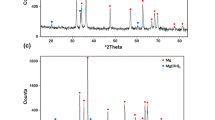Abstract
Stress corrosion cracking of HY-180M steel was studied at 22°C in an aqueous solution of 3.5 pct NaCl (pH = 6.5). The steel had a nominal weight percentage composition of 10Ni-14Co-2Cr-lMo-0.16C and was heat treated to yield a fracture toughness value ofK Ic ≃ 160 MPa . m1/2. The SCC velocity (v) was studied as a function of stress intensity (K I) and electrochemical potential (E) using precracked compact tension specimens, a Ag/AgCl reference electrode and a 1000 h exposure test. Also, the polarization behavior, microstructure, fractography and corrosion products were studied. The results showed that SCC was markedly dependent uponE, and did not occur whenE =-0.52 VSHE (-0.72 VAg/AgCl), which corresponded closely to the thermodynamically reversible potential of iron. However, SCC occurred at a more noble potential of-0.28 VSHE (-0.48 VAg/AgCl ) and at a less noble potential of-0.80 VSHE (-1.00 VAg/AgCl). The stress intensity below which SCC was not observed was KISCC ≃ 5.5 MPa . m1/2 at -0.28 VSHE and KISCC ≃ 60 MPa . m1/2 at -0.80 VSHE . Also, Region I behavior (v dependent uponK 1) and Region II behavior (v independent ofK 1) were observed. Cracking was considered to occur solely by hydrogen embrittlement at -0.80 Vshe, whereas anodic dissolution processes played a necessary role, either directly or indirectly, in SCC at -0.28 VSHE . The indirect effects were discussed in relation to hydrolysis effects in the crack promoting hydrogen embrittlement and/or corrosion product wedging stresses.
Similar content being viewed by others
References
C. D. Little and P. M. Machmeier:Development of a Weldable High Strength Steel, Rep. No. 1, Contract No. F33615-73-C-5093, General Dynamics, Fort Worth Div., July 1974.
G. R. Speich, D. S. Dabkowski, and L. F. Porter:Met. Trans., 1973, vol. 4, pp. 303–15.
J. A. Snide:Some Aspects of the Physical Metallurgy and Weldability of 10 Nickel Modified Steel, Ph.D. Thesis, Ohio State University, 1975.
ASTM E399-72,ASTM, Philadelphia, May 1972.
M. O. Speidel and M. V. Hyatt:Adv. Corros. Sci. Technol., 1972, vol. 2, pp. 115–335.
W. F. B own, Jr. and J. E. Srawley:Plane Strain Crack Toughness Testing of High Strength Metallic Materials STP 410, ASTM, Philadelphia, 1966.
J. M. Marder and A. R. Marder:Trans. ASM Quart., 1969, vol. 62, pp. 1–10.
H. H. Uhlig:Corrosion and Corrosion Control, J. Wiley, N.Y., 1971,
J. H. Morgan:Cathodic Protection, L. Hill Ltd., London, 1959.
NACE Tech. Committee T-2U:Recommended Practice for Cathodic Protec- tion of Aluminum Pipe Buried in Soil or Immersed in Water NACE Pub. 2M363,June 1963.
P. A. Parrish, C. M. Chen, and E. D. Verink, Jr.:Stress Corrosion-New Ap- proaches, STP 410,H.L. Craig, Jr., ed., pp. 189–98, ASTM, Philadelphia, 1976.
B. F. Brown:The Theory of Stress Corrosion Cracking in Alloys, J. C. Scully, ed., pp. 186–203, NATO, Sci. Aff. Div., Brussels, 1971.
I. David and J. E.Welch:Trans. Faraday Soc, 1956, vol. 52, pp. 1642–50.
C. L. Foley, J. Kruger, and C. J. Bechtoldt:J. Electrochem. Soc, 1967, vol. 114, pp. 994–1001.
M. Pourbaix:The Theory of Stress Corrosion Cracking in Alloys, J. C. Scully, ed., pp. 17–61, NATO Sci. Aff. Div., Brussels, 1971.
T. Misawa, T. Kyuno, W. Suetaka, and S. Shimodaira:Corros. Sci., 1971, vol. 11, pp. 35–48.
H. P. Leckie:Fundamental Aspects of Stress Corrosion Cracking, R. W. Staehle, A. J. Forty, and D. van Rooyen,eds., pp. 411–17, NACE, Houston, 1969.
N. A. Nielsen:Physical Metallurgy of Stress Corrosion Cracking, T. N. Rhodin, ed., pp. 121–43, Interscience, N.Y., 1959.
R. G. Weast:Handbook of Chemistry andPhysics, Chemical Rubber Co., Cleveland, 1968.
H. H. Johnson:Fundamental Aspects of Stress Corrosion Cracking, R. W. Staehle, A. J. Forty, and D. van Rooyen, eds., pp. 439–44, NACE, Houston, 1969.
N. A. Tiner and C. B. Gilpin:Corrosion, 1966, vol. 22, pp. 271–79.
J. M. West:Electrodeposition and Corrosion Processes, D. van Nostrand Co., London, 1965.
K.J. Vetter:Electrochemical Kinetics, Academic Press, N.Y., 1967.
F. Mansfeld:Adv. Corros. Sci., 1976, vol. 6, pp. 163–262.
M. Pourbaix:Atlas of Electrochemical Equilibria in Aqueous Solutions, Pergamon Press, N.Y., 1966.
W. K. Wilson:Eng. Fract. Mech., 1970, vol. 2, pp. 169–71.
C.D. Beachem:Met. Trans., 1972, vol. 3, pp. 437–51.
American Inst. Physics Handbook, D. E. Gray, ed., pp. 2–118, McGraw-Hill, N.Y., 1957.
Author information
Authors and Affiliations
Rights and permissions
About this article
Cite this article
Bala, S.r., Tromans, D. Stress corrosion cracking of high strength HY-180M steel in 3.5 Pct NaCl. Metall Trans A 9, 1125–1132 (1978). https://doi.org/10.1007/BF02652217
Received:
Issue Date:
DOI: https://doi.org/10.1007/BF02652217




